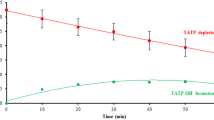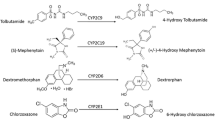Abstract
Purpose
This work is performed to determine if there is a potential for the accumulation and potential toxicity of triacetone triperoxide (TATP) in canines. Additional utility of this information may suggest human toxicity and possibly detection of biomarkers, metabolites or intact molecule of those using this material for nefarious reasons.
Methods
Liquid chromatography/mass spectrometry of dog liver microsome (DLM) incubation samples of TATP was used to measure substrate depletion. Trapping of electrophilic products was performed using glutathione (GSH) and semicarbazide. Comparisons were made to free hydroperoxides found in methyl ethyl ketone peroxides (MEKP).
Results
The non-specific Km value of 2.2 μM and a Vmax of 1.1 nmol/min/mg of protein were determined. Canine recombinant cytochrome P450 (rCYP) 2B11 with human cytochrome b5 was found to catalyze the NADPH-dependent metabolism of TATP into its only phase I metabolite, hydroxy-TATP (TATP-OH). No secondary metabolite(s) or degraded products were detected or trapped from microsomal incubations. MEKP subjected to similar conditions was found to undergo significant metabolism, semicarbazide trapping and rapid oxidation of GSH to GSSG. The synthesized TATP-OH metabolite incubated in DLM progressed three times faster than TATP metabolism with no secondary metabolites found or trapped.
Conclusions
TATP does not react as MEKP suggesting that TATP does not ring-open to form hydroperoxides. TATP and TATP-OH compete for the same enzyme, with TATP dominating this competition. Failure to detect additional metabolite(s) suggests they may be too small to detect by our system or bound covalently to a protein or polymer in the incubation reaction.












Similar content being viewed by others
References
Channon HJ, Mills GT, Williams RT (1944) The metabolism of 2:4:6-trinitrotoluene (a-T.N.T.). Biochem J 38:70–85
Buedingg E, Jolliffe N (1946) Metabolism of trinitrotoluene (TNT) in vitro. J Pharmacol Exp Ther 88:300–312. https://doi.org/10.1007/bf01571053
DiCarlo FJ, Crew MC, Sklow NJ, Coutinho CB, Nonkin P et al (1966) Metabolism of pentaerythritol tetranitrate by patients with coronary artery disease. J Pharmacol Exp Ther 153:254–258
Davidson IWF, Miller HS, Dicarlo FJ (1970) Absorption, excretion and metabolism of pentaerythritol tetranitrate by humans. J Pharmacol Exp Ther 175:42–50
Don Van Natta J, Sciolino E, Grey S (2006) Details emerge in British terror case. The New York Times. https://www.nytimes.com/2006/08/28/world/europe/28plot.html. Accessed 28 Oct 2017
Fikes BJ (2012) REGION: Escondido “bomb house” controlled burn a model for nation, expert says. The San Diego Union-Tribune. http://www.sandiegouniontribune.com/sdut-region-escondido-bomb-house-controlled-burn-a-2012mar26-story.html. Accessed 3 Nov 2017
Morris S (2009) Terror suspect student ‘had suicide vest and explosives’. The Gaurdian. https://www.theguardian.com/uk/2009/jun/04/terror-suspect-isa-ibrahim. Accessed 03 Nov 2017
Oxley JC, Smith JL, Moran J, Nelson K, Utley WE (2004) Training dogs to detect triacetone triperoxide. In: Proceedings of SPIE—The International Society for Optical Engineering, Proc. SPIE 5403, Sensors, and Command, Control, Communications, and Intelligence (C3I) Technologies for Homeland Security and Homeland Defense III (15 September 2004). https://doi.org/10.1117/12.555791
Boveris A, Cadenas E (2000) Mitochondrial production of hydrogen peroxide regulation by nitric oxide and the role of ubisemiquinone. IUBMB Life 50:245–250. https://doi.org/10.1080/713803732
Hayyan M, Hashim MA, Alnashef IM (2016) Superoxide ion: generation and chemical implications. Chem Rev 116:3029–3085. https://doi.org/10.1021/acs.chemrev.5b00407
Karuzina II, Archakov AI (1994) Hydrogen peroxide-mediated inactivation of microsomal cytochrome P450 during monooxygenase reactions. Free Radic Biol Med 17:557–567. https://doi.org/10.1016/0891-5849(94)90095-7
Kundu TK, Hille R, Velayutham M, Zweier JL (2007) Characterization of superoxide production from aldehyde oxidase: an important source of oxidants in biological tissues. Arch Biochem Biophys 460:113–121. https://doi.org/10.1016/j.abb.2006.12.032
Bayne AC, Mockett RJ, Orr WC, Sohal RS (2005) Enhanced catabolism of mitochondrial superoxide/hydrogen peroxide and aging in transgenic Drosophila. Biochem J 391:277–284. https://doi.org/10.1042/bj20041872
Jones DP, Eklöw L, Thor H, Orrenius S (1981) Metabolism of hydrogen peroxide in isolated hepatocytes: relative contributions of catalase and glutathione peroxidase in decomposition of endogenously generated H2O2. Arch Biochem Biophys 210:505–516. https://doi.org/10.1016/0003-9861(81)90215-0
Martins D, English AM (2014) Catalase activity is stimulated by H2O2 in rich culture medium and is required for H2O2 resistance and adaptation in yeast. Redox Biol 2:308–313. https://doi.org/10.1016/j.redox.2013.12.019
Vaz ADN, Coon MJ (1987) Hydrocarbon formation in the reductive cleavage of hydroperoxides by cytochrome P450. Proc Natl Acad Sci 84:1172–1176
Chefson A, Zhao J, Auclair K (2006) Replacement of natural cofactors by selected hydrogen peroxide donors or organic peroxides results in improved activity for CYP3A4 and CYP2D6. ChemBioChem 7:916–919. https://doi.org/10.1002/cbic.200600006
Degousee N, Triantaphylides C, Starek S, Iacazio G, Martini D et al (1995) Measurement of thermally produced volatile alkanes: an assay for the plant hydroperoxy fatty acid evaluation. Anal Biochem 224:524–531. https://doi.org/10.1006/abio.1995.1082
Litov RE, Matthews LC, Tappel AL (1981) Vitamin E protection against in vivo peroxidation initiated in rats by methyl ethyl ketone peroxide as monitored by pentane. Toxicol Appl Pharmacol 55:96–106. https://doi.org/10.1016/0041-008x(81)90456-7
Hix S, Kadiiska MB, Mason RP, Augusto O (2000) In vivo metabolism of tert-butyl hydroperoxide to methyl radicals. EPR spin-trapping and DNA methylation studies. Chem Res Toxicol 13:1056–1064. https://doi.org/10.1021/tx000130l
Hix S, Augusto O (1999) DNA methylation by tert-butyl A role for the transition metal ion in the production of DNA base adducts. Chem Biol Interact 118:141–149. https://doi.org/10.1016/s0009-2797(99)00079-4
Mlochowski J, Brzaszcz M, Giurg M, Palus J, Wojtowicz H (2003) Selenium-promoted oxidation of organic compounds: reactions and mechanisms. Eur J Org Chem 2003:4329–4339. https://doi.org/10.1002/ejoc.200300230
Tapiero H, Townsend DM, Tew KD (2003) The antioxidant role of selenium and seleno-compounds. Biomed Pharmacother 57:134–144. https://doi.org/10.1016/s0753-3322(03)00035-0
Tinggi U (2008) Selenium: its role as antioxidant in human health. Environ Health Prev Med 13:102–108. https://doi.org/10.1007/s12199-007-0019-4
Bozdemir MN, Yildiz M, Seyhanli ES, Gurbuz S, Kilicaslan I et al (2011) Narrowing of airway caused by ingestion of methyl ethyl ketone peroxide. Hum Exp Toxicol 30:2002–2006. https://doi.org/10.1177/0960327111407230
Muraleedharan KM, Avery MA (2009) Progress in the development of peroxide-based anti-parasitic agents. Drug Discov Today 14:793–803. https://doi.org/10.1016/j.drudis.2009.05.008
Jefford CW (2007) New developments in synthetic peroxidic drugs as artemisinin mimics. Drug Discov Today 12:487–495. https://doi.org/10.1016/j.drudis.2007.04.009
Opsenica DM, Solaja BA (2009) Antimalarial peroxides. J Serbian Chem Soc 74:1155–1193. https://doi.org/10.2298/jsc0911155
Antoine T, Fisher N, Amewu R, O’Neil PM, Ward S et al (2014) Rapid kill of malaria parasites by artemisinin and semi-synthetic endoperoxides involves ROS-dependent depolarization of the membrane potential. J Antimicrob Chemother 69:1005–1016. https://doi.org/10.1093/jac/dkt486
Haynes RK, Cheu KW, Chan HW, Wong HN, Li KY et al (2012) Interactions between artemisinins and other antimalarial drugs in relation to the cofactor model—A unifying proposal for drug action. ChemMedChem 7:2204–2226. https://doi.org/10.1002/cmdc.201200383
Ramasarma T (1982) Generation of H2O2 in biomembranes. Biochim Biophys Acta Rev Biomembr 694:69–93. https://doi.org/10.1016/0304-4157(82)90014-4
Oxley JC, Smith JL, Luo W, Brady J (2009) Determining the vapor pressures of diacetone diperoxide (DADP) and hexamethylene triperoxide diamine (HMTD). Propellants Explos Pyrotech 34:539–543. https://doi.org/10.1002/prep.200800073
Oxley JC, Smith JL, Porter M, McLennan L, Colizza K et al (2016) Synthesis and degradation of hexamethylene triperoxide diamine (HMTD). Propellants Explos Pyrotech 41:334–350. https://doi.org/10.1002/prep.201500151
Oxley JC, Smith JL, Shinde K, Moran J (2005) Determination of the vapor density of triacetone triperoxide (TATP) using a gas chromatography headspace technique. Propellants Explos Pyrotech 30:127–130. https://doi.org/10.1002/prep.200400094
Colizza K, Yevdokimov A, Mclennan L, Smith JL, Oxley JC (2018) Reactions of organic peroxides with alcohols in atmospheric pressure chemical ionization—the pitfalls of quantifying triacetone triperoxide (TATP). J Am Soc Mass Spectrom 29:393–404. https://doi.org/10.1007/s13361-017-1836-3
Minh VD, Dolan GF, Brach BB, Moser KM (1978) Functional residual capacity and body position in the dog. J Appl Physiol 44:291–296. https://doi.org/10.1152/jappl.1978.44.2.291
Barrett K, Brooks H, Boitano S, Barman S (2010) Ganong’s review of medical physiology, 23rd edn. McGraw Hill, New York, pp 261–272
Colizza K, Yevdokimov A, McLennan L, Smith JL, Oxley JC (2018) Using gas phase reactions of hexamethylene triperoxide diamine (HMTD) to improve detection in mass spectrometry. J Am Soc Mass Spectrom 29:675–684. https://doi.org/10.1007/s13361-017-1879-5
Colizza K, Mahoney KE, Yevdokimov AV, Smith JL, Oxley JC (2016) Acetonitrile ion suppression in atmospheric pressure ionization mass spectrometry. J Am Soc Mass Spectrom. https://doi.org/10.1007/s13361-016-1466-1
Oxley JC, Smith JL, Bowden PR, Rettinger RC (2013) Factors influencing triacetone triperoxide (TATP) and diacetone diperoxide (DADP) formation: part 1. Propellants Explos Pyrotech 38:244–254. https://doi.org/10.1002/prep.201200116
Smith ME, Wall C, Fitzgerald M (2012) Characterisation of the major synthetic products of the reactions between butanone and hydrogen peroxide. Propellants Explos Pyrotech 37:282–287. https://doi.org/10.1002/prep.201100091
Milas NA, Golubovic A (1959) Studies in organic peroxides. XXV. Preparation, separation and identification of peroxides derived from methyl ethyl ketone and hydrogen peroxide. J Am Chem Soc 81:5824–5826. https://doi.org/10.1021/ja01530a068
Court MH (2014) Canine cytochrome P450 (CYP) pharmacogenetics. NIH Public Access 43:1027–1038. https://doi.org/10.1016/j.cvsm.2013.05.001
Linder CD, Renaud NA, Hutzler JM (2009) Is 1-Aminobenzotriazole an appropriate in vitro tool as a nonspecific cytochrome P450 inactivator? Drug Metab Dispos 37:10–13. https://doi.org/10.1124/dmd.108.024075
Bondoc FY, Bao Z, Hu WY, Gonzalez FJ, Wang Y et al (1999) Acetone catabolism by cytochrome P450 2E1: studies with CYP2E1-null mice. Biochem Pharmacol 58:461–463. https://doi.org/10.1016/s0006-2952(99)00111-2
Koop DR, Casazza JP (1985) Identification of ethanol-inducible P-450 isozyme 3a as the acetone and acetol monooxygenase of rabbit microsomes. J Biol Chem 260:13607–13612
Acknowledgements
This material is based upon work supported by U.S. Department of Homeland Security (DHS), Science & Technology Directorate, Office of University Programs, under Grant 2013-ST-061-ED0001. Views and conclusions are those of the authors and should not be interpreted as necessarily representing the official policies, either expressed or implied, of DHS.
Author information
Authors and Affiliations
Corresponding author
Ethics declarations
Conflict of interest
The authors have no conflict of interest to declare.
Ethical approval
Samples produced using human cytochrome b5 or human reductase bactosomes are not recovered from any human patients and are not subject to human biological sample management required by GxP.
Electronic supplementary material
Below is the link to the electronic supplementary material.
Rights and permissions
About this article
Cite this article
Colizza, K., Gonsalves, M., McLennan, L. et al. Metabolism of triacetone triperoxide (TATP) by canine cytochrome P450 2B11. Forensic Toxicol 37, 174–185 (2019). https://doi.org/10.1007/s11419-018-0450-9
Received:
Accepted:
Published:
Issue Date:
DOI: https://doi.org/10.1007/s11419-018-0450-9




